President Muizzu Vows to End Tourism Void in Haa Dhaalu, Pledges Comprehensive Development for Naivaadhoo
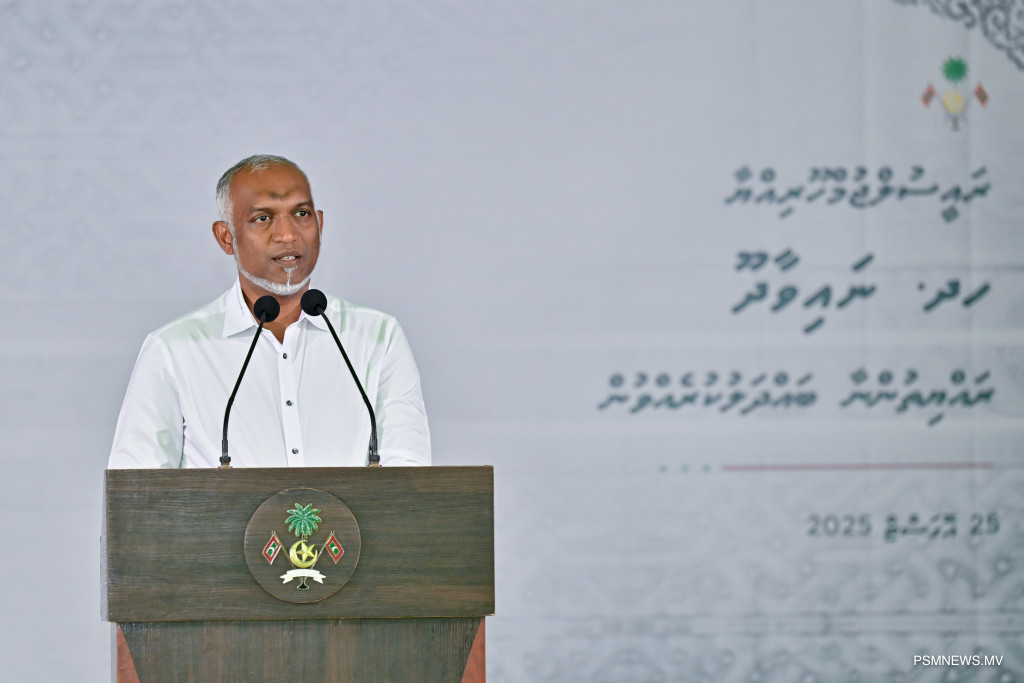
President Dr Mohamed Muizzu pledged to end the longstanding absence of tourism infrastructure in Haa Dhaalu Atoll, committing to its transformation into a viable destination during an address to residents of Naivaadhoo. His remarks outlined a broad-based strategy to stimulate regional development, encompassing tourism, infrastructure, public services, and youth engagement.
Government to revive stalled Naagoashi resort project
Central to the tourism strategy is the recommencement of resort development on Naagoashi island. The site, originally leased to the Maldives Tourism Development Corporation (MTDC) in 2006 and sub-leased to a Russian firm, saw initial progress halted in 2012 due to financial constraints. Following its reclamation in 2017, the island was re-leased in 2021 to UAE-based R.A.W. Galadari Holdings. With no advancement over three years, that agreement was annulled.
President Muizzu confirmed that the Ministry of Finance and Planning has now extended facilitative support to MTDC to resume the project. He described the initiative as a long-standing concern that will be prioritised for immediate action. The administration’s renewed efforts, President Muizzu stated, are expected to position Naagoashi as a viable tourism destination and contribute to broader economic revitalisation across the atoll.
Investment incentives attract interest in Haa Dhaalu Atoll
To attract investment to underserved regions, the government introduced a suite of incentives and concessions in June. These measures have already prompted expressions of interest and active bidding for approximately ten lagoons and lagoon segments within Haa Dhaalu Atoll, President Muizzu elaborated.
The president reiterated that expanding tourism into previously neglected areas remains a central tenet of his administration’s manifesto. This commitment, reaffirmed during his presidential address at the opening of Parliament, is intended to ensure that local communities derive direct benefit from tourism-led development.
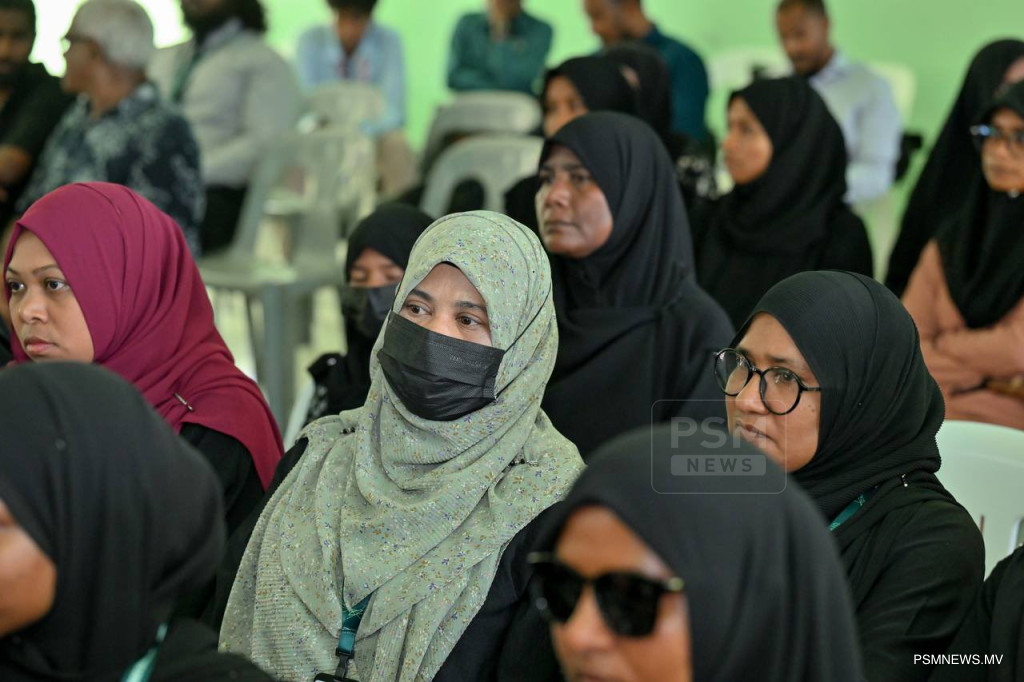
Infrastructure projects move forward across Naivaadhoo
In addition to tourism, President Muizzu outlined a comprehensive development agenda for Naivaadhoo. His address detailed plans to accelerate existing projects and initiate new ones across infrastructure, healthcare, utilities, and education, each tailored to meet the island’s evolving needs.
School hall and harbour construction to be expedited
Among the initiatives highlighted was the school hall project, which had faced delays but is now expected to proceed swiftly following the resolution of initial challenges. A new harbour is under construction, with assurances that it will reflect modifications requested by residents.
The sewerage system has reached 80 percent completion and is progressing without impediment. The president expressed confidence in its timely finalisation, noting that technical difficulties have been resolved.
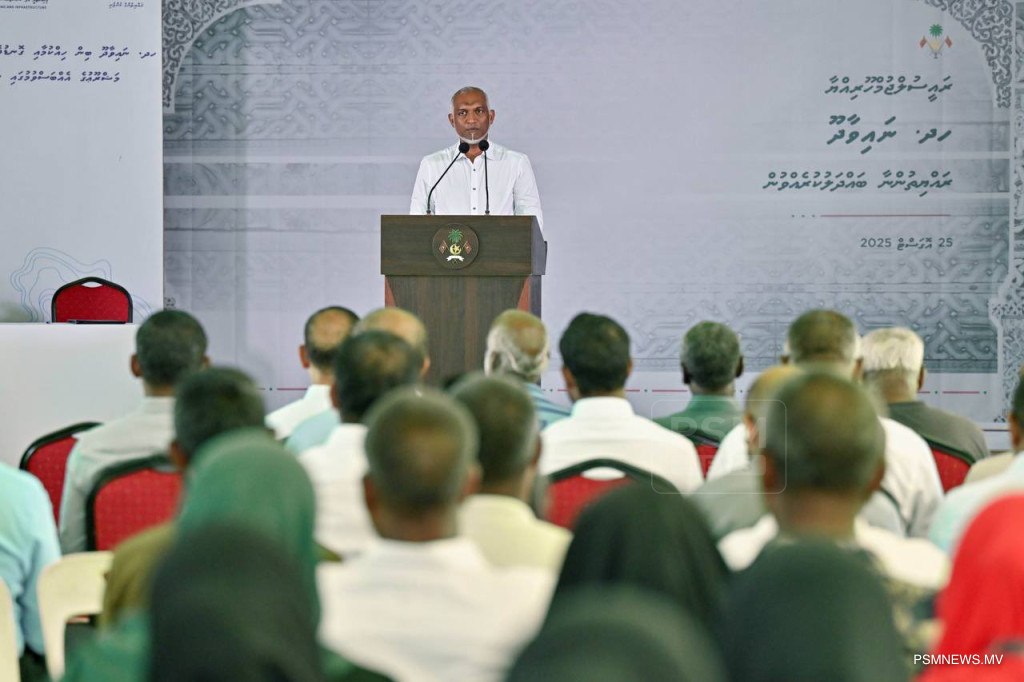
Road upgrades and power supply improvements planned
Plans are in place to upgrade Naivaadhoo’s road network to modern standards, with construction scheduled to commence next year. To address electricity shortages, the government will procure a new generator set to enhance power reliability, the president announced.
Health centre expansion and ambulance procurement announced
Healthcare infrastructure is also slated for expansion, according to President Muizzu. He announced that the budget for next year will include provisions for a new health centre building and upgraded facilities. He added that laboratory services will be strengthened, and the urgent need for an ambulance will be addressed as a priority.
Council-led land use planning to support local tourism
The administration’s development vision includes economic diversification, President Muizzu said, noting that a land-use plan for the two islands under Naivaadhoo’s jurisdiction may be formulated by the local council to pave the way for further progress. Support for tourism promotion, particularly local tourism, which remains underdeveloped, was reaffirmed.
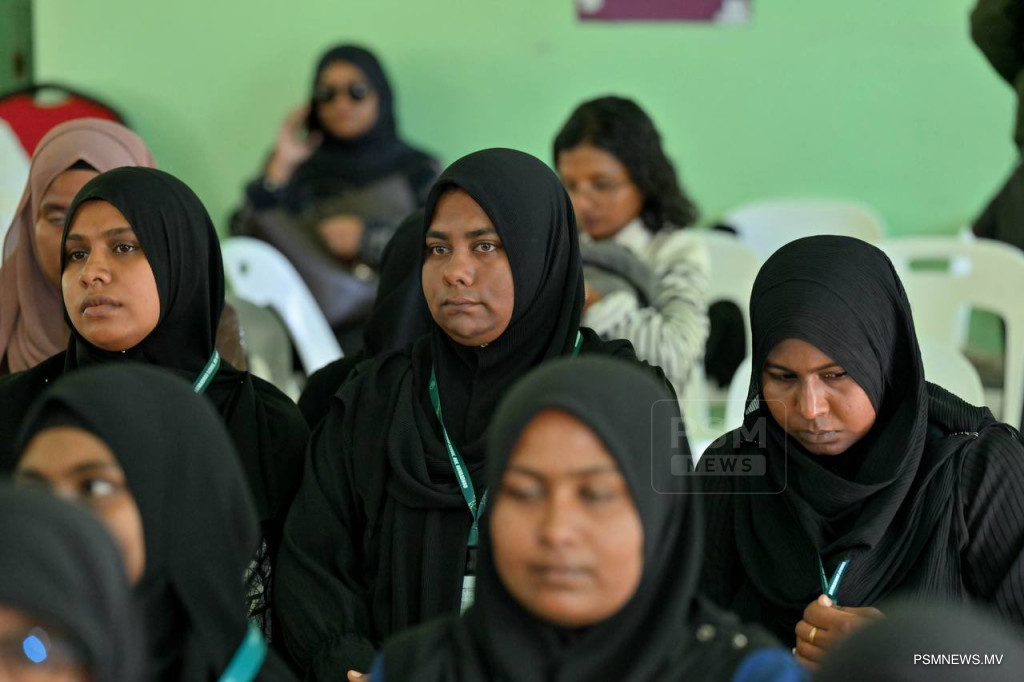
Football stadium to be built for Naivaadhoo youth
Recognising Naivaadhoo’s strong footballing tradition, President Muizzu announced the imminent commencement of a state-of-the-art stadium. A development partner has been secured, and practical work is expected to begin shortly, he said.
The facility is designed for both daytime and evening use, with lighting and perimeter fencing to accommodate local athletic activities. The president underscored the importance of the project for youth development, noting that the existing football ground remains underutilised despite the island’s sporting success.
President consults with island leaders on community priorities
During his visit, President Muizzu convened a consultative session with the island council, the women’s development committee, and senior representatives from local institutions at Naivaadhoo School. Council members expressed satisfaction with the harbour expansion and proposed additional enhancements.
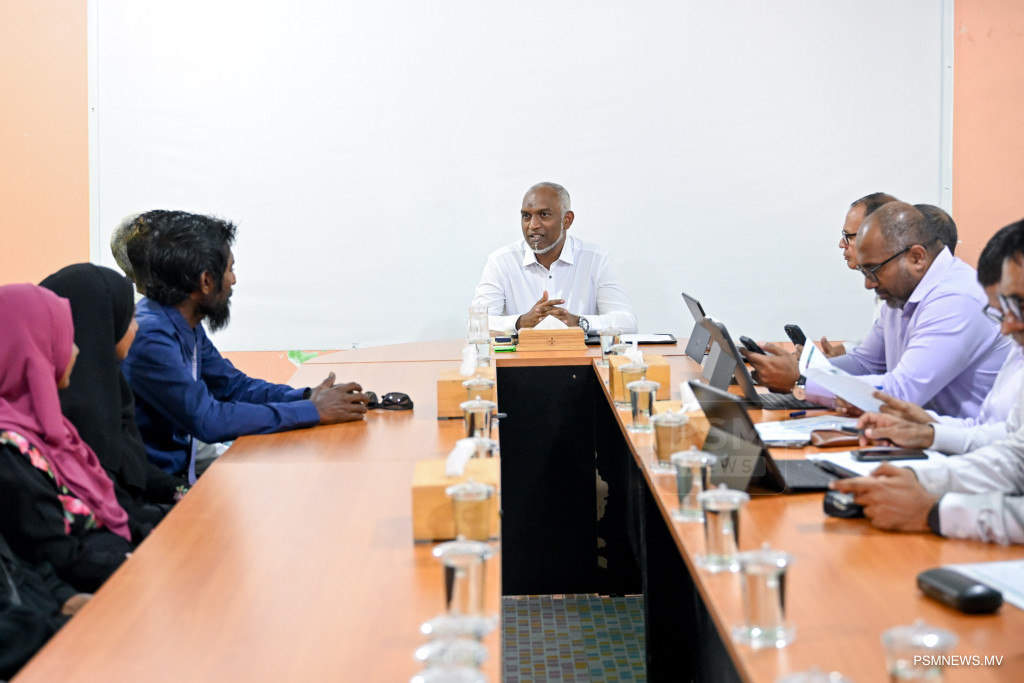
Concerns were raised regarding the limited capacity of the healthcare centre and the absence of an ambulance. The need for an additional generator to stabilise electricity supply was also noted.
School representatives cited classroom shortages and staffing constraints, requesting prompt intervention. The council further advocated for the installation of a fish aggregating device to support the growing interest in sports fishing among the youth. The president assured the council members that all concerns would be carefully considered, and ministers and state company officials provided updates on ongoing projects.
MTCC awarded contract for land reclamation and coastal protection
A formal agreement was signed during the president’s visit, appointing the Maldives Transport and Contracting Company (MTCC) as the contractor for the Naivaadhoo land reclamation and coastal protection project. The initiative, awarded by the Ministry of Construction, Housing and Infrastructure, responds to longstanding concerns over land scarcity for housing, industrial use, and other essential community needs.
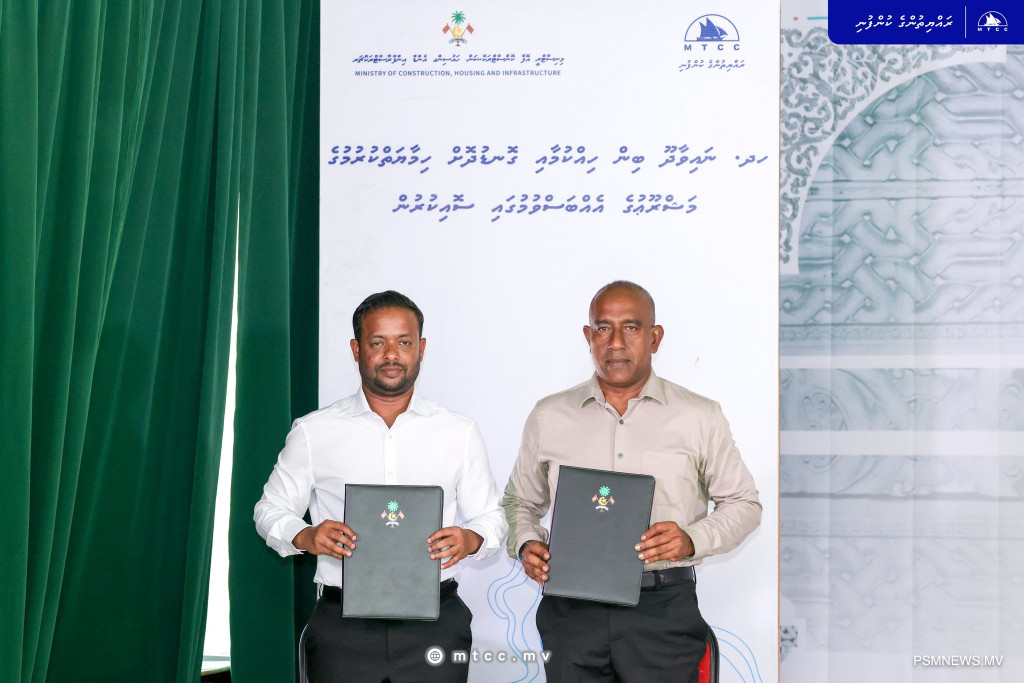
The signing ceremony, held during a public meeting with residents, saw Construction Minister Dr Abdulla Muththalib and MTCC Managing Director Ahmed Saudee affix their signatures. President Muizzu underscored the strategic importance of the project, citing its potential to stimulate economic development and improve living standards on the island.
New ATM installation brings round-the-clock banking access
As part of his tour of Naivaadhoo, President Muizzu inaugurated new Bank of Maldives (BML) ATM services on the island, which government officials describe as a key step toward improving financial accessibility for local residents. The installation forms part of a broader national initiative to decentralise banking infrastructure and improve service delivery across the country. To commemorate the launch, the president unveiled a plaque, which was formally presented to Naivaadhoo Council President Ali Rasheed Mohamed.

The self-service ATM, now operational 24 hours a day, offers a comprehensive suite of banking functions for individuals and businesses. These include cash withdrawals, deposits, bill payments, and fund transfers. According to BML, the initiative reflects a collaborative effort with the government to bring essential financial services closer to communities, enhancing convenience and economic participation.
The Naivaadhoo installation is one of ten ATM inaugurations planned during the president’s current tour. The project aligns with his pledge to establish ATM services in all inhabited islands of the Maldives. BML has committed to installing services in more than 100 new islands this year.
Naivaadhoo council office project reflects broader decentralisation agenda
The government has launched two major infrastructure projects on Naivaadhoo: the construction of a new council office and a police station. Both developments were inaugurated during President Muizzu’s visit and reflect his administration’s broader commitment to strengthening decentralised governance and expanding law enforcement services nationwide.
The new council office forms part of a five-year programme to replace deteriorating administrative buildings across more than 100 islands. The initiative prioritises locations where existing infrastructure is no longer fit for purpose, aiming to reinforce the operational capacity of local councils.
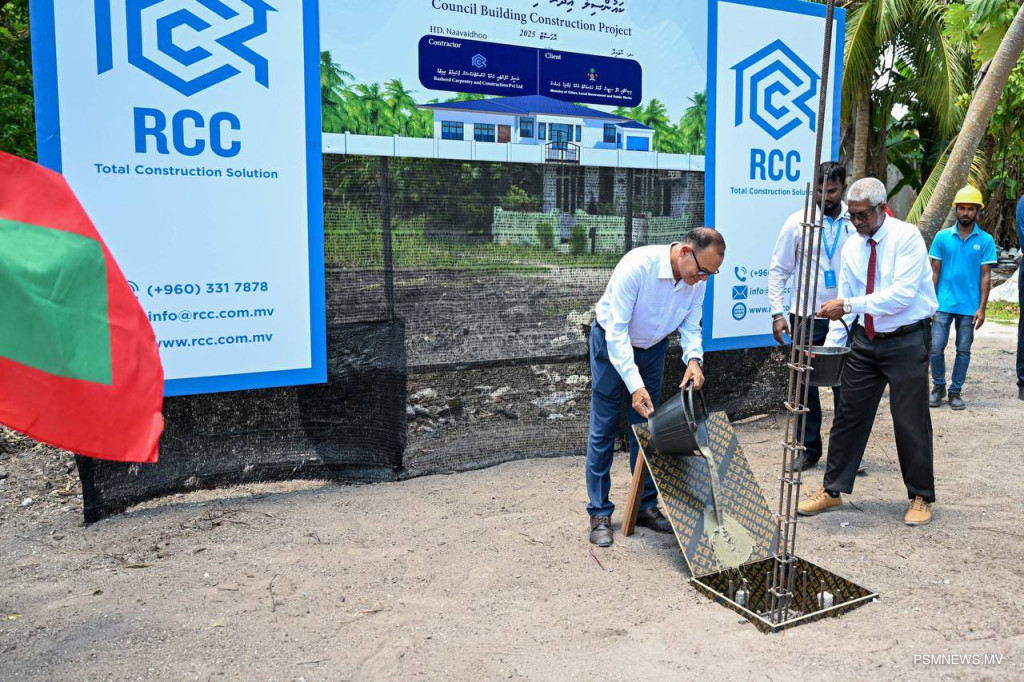
At the foundation-laying ceremony, Adam Shareef Umar, Minister of Cities, Local Government and Public Works, was joined by Ali Rasheed Mohamed, President of the Naivaadhoo Council. The contract for construction has been awarded to Rasheed Carpentry and Construction Pvt. Ltd. (RCC), which is responsible for delivering council offices in 55 islands under a contractor-financed model. The total value of RCC’s engagement stands at USD 40.94 million.
Complementing this effort, an additional 50 council buildings are scheduled for development under a grant aid arrangement with the government of China. The bilateral initiative was formalised in May through a Letter of Exchange signed between the two governments.
Police station construction begins as part of nationwide law enforcement expansion
In a parallel effort to enhance public safety infrastructure, construction has also begun on a new police station in Naivaadhoo. The project aligns with President Muizzu’s policy to establish law enforcement facilities on every inhabited island, with the nationwide rollout targeted for completion within two years. Work has already commenced in several locations currently lacking police presence.
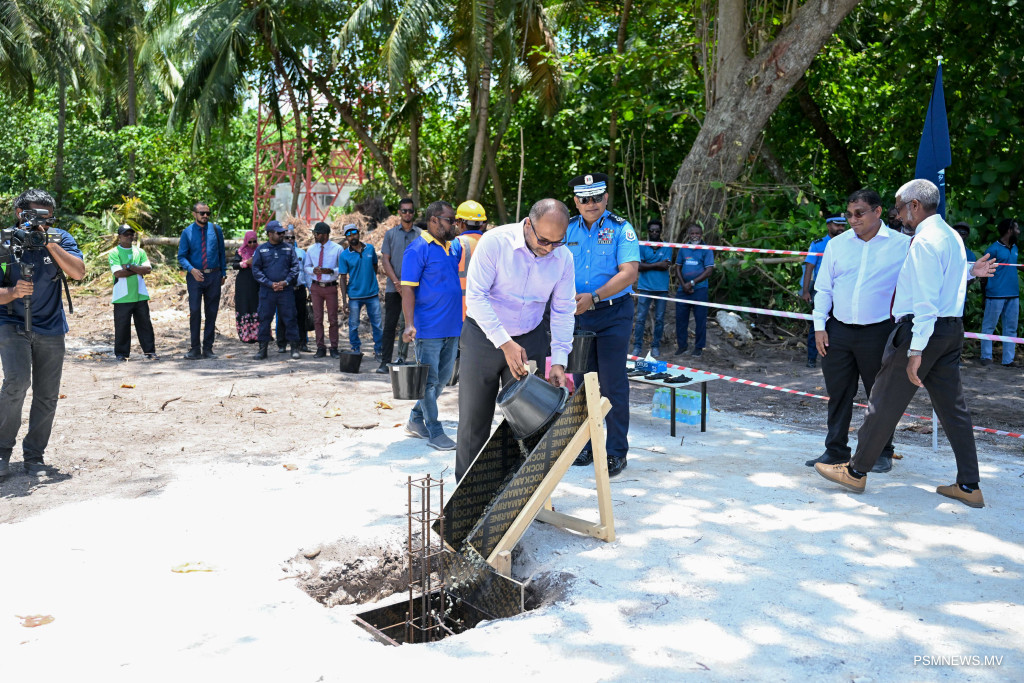
The ceremony marking the start of construction was officiated by Ali Ihusaan, Minister of Homeland Security and Technology, alongside Commissioner of Police Ismail Naveen. Also present were Mohamed Najaah, Managing Director of Fenaka Corporation, and Council President Ali Rasheed Mohamed. Fenaka Corporation has been awarded the contract for the police station’s construction.
New futsal field signals broader investment in youth and community engagement
As part of his regional tour, President Muizzu formally inaugurated a newly constructed futsal field on the island of Naivaadhoo, in a ceremony aligned with the official itinerary. The project, commissioned by the government and completed over two and a half years by a private contractor, addresses a longstanding absence of dedicated sports facilities on the island. The new field is expected to significantly improve conditions for organised futsal, offering a formal venue for training and competition that had previously been unavailable.
Naivaadhoo has a well-established sporting culture, with its futsal team having achieved runner-up status in the Golden Futsal tournament despite limited resources. The island is also known for producing national-level athletes, including members of the women’s futsal team. Local council officials expressed optimism that the facility will support youth development through structured training programmes, while also fostering broader community engagement and reinforcing Naivaadhoo’s position within the national sports landscape.

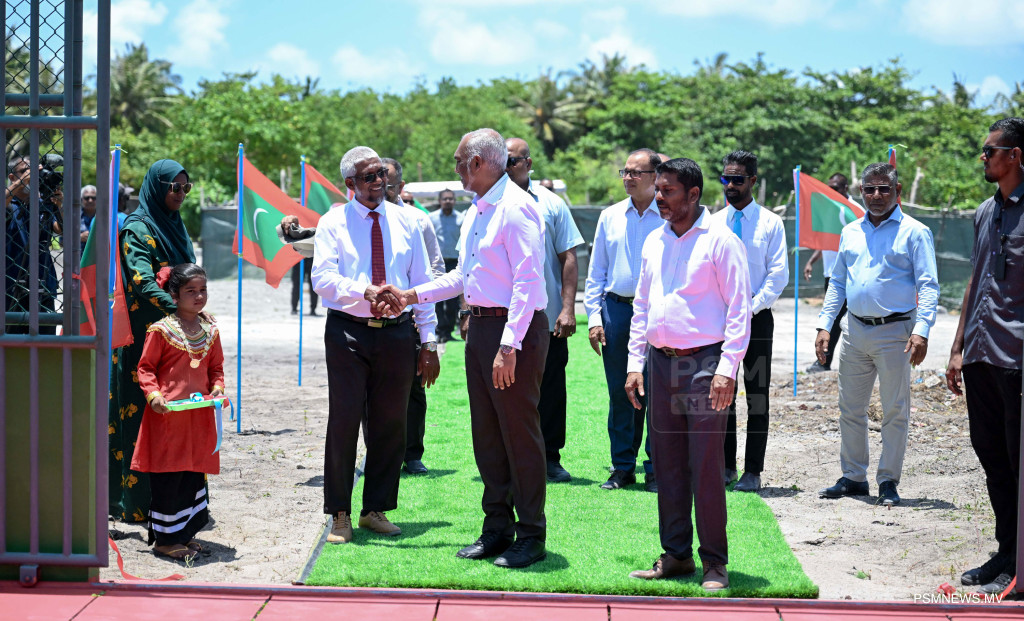


Fitness centre project reflects targeted investment in island-based public health
President Muizzu's visit to Naivaadhoo also featured the inauguration of the foundation of a new fitness and recreation centre, reinforcing the administration’s commitment to public health infrastructure. The ceremony brought together senior officials, including Minister of Sports, Fitness and Recreation Abdulla Rafiu; Maldives Airports Company Limited (MACL) Managing Director Ibrahim Shareef Mohamed; and Naivaadhoo Council President Ali Rasheed Mohamed. Commissioned to MACL, the facility will house indoor sports amenities, board games, an aerobics studio accessible to all genders, classrooms for theoretical instruction, a meeting room, and administrative offices.
The Naivaadhoo project is one of several developments under a national programme aimed at establishing fitness and recreation centres across the country. Implementation has been distributed among key state-owned enterprises, Maldives Transport and Contracting Company (MTCC), Fenaka Corporation, Road Development Corporation (RDC), and MACL, with the latter assigned to oversee 63 such facilities.

President receives warm welcome during fourth stop in island tour
Arriving in Naivaadhoo on Monday morning, President Muizzu was greeted by a large number of residents, alongside members of the island council and senior officials from local institutions. The visit marked the fourth stop in a comprehensive itinerary that includes all thirteen inhabited islands within Haa Dhaalu Atoll.


His delegation comprises several cabinet ministers and high-ranking representatives from government agencies. The tour is part of a broader engagement strategy aimed at assessing local development priorities and advancing key infrastructure and service delivery projects across the region.
